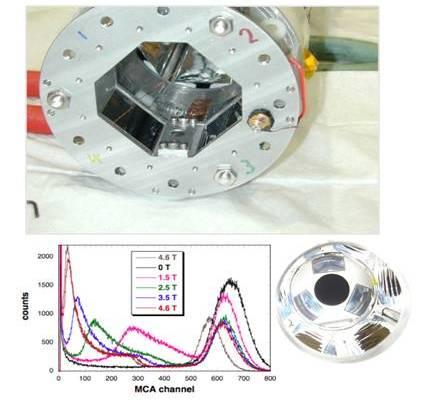Applied: X-ray Detection with Large Area Avalanche Photodiodes for the Neutron Radiative Decay Experiment
Summary
Operation of the second neutron radiative decay experiment was completed. In the experiment we observed the emission of photons that accompany neutron beta decay and measured the branching ratio of the process along with energy of the emitted photons. Large-area avalanche photodiodes were used to measure the lower energy photons, and many of their properties were studied to understand their response under the conditions of the experiment.
Description

On the top is shown the first version of the X-ray detector; in which the magnetic field was perpendicular to the APD electric field. The effects of the magnetic field on the response of the APD to 5.9 keV X-rays are shown in the bottom left plot. On the bottom right is shown the three-APD detector used for the radiative decay experiment, looking through the scintillator detector.
The primary photon detector was a 12-element array of scintillating crystals coupled to avalanche photodiodes (APDs) which operated between 10 and 700 keV. The overall energy range for the experiment was extended with a three-element array of large area APDs to directly detect X-rays with energies between 0.3 and 20 keV. X-ray detection with APDs for our operating conditions (cryogenic temperatures (77 K) along with high magnetic fields) had never been presented in the published literature. In the development and application of this detector, we observed previously undocumented and unexpected magnetic field effects on APDs, in particular for the case in which the APD electric field is perpendicular to an applied magnetic field. Studies of the temperature (77 - 300 K) and magnetic field (0 - 5 T) dependence of the APD response were performed in this configuration and reported in T.R. Gentile, C.D. Bass, J.S. Nico, H. Breuer and R. Farrell, Nucl. Instrum. Meth. A 652, 520-523 (2011). The key result is that the magnetic field effects are not present at room temperature, and are associated with X-rays that are absorbed in the drift region of the APD.
For the radiative decay experiment, we operated with the electric field parallel to the magnetic field, in which field effects were minor. However, the response of APDs at the low end of our energy range (below 1.5 keV) had not previously been investigated. In measurements at the NIST Synchrotron Radiation Facility, we found a complex response function in this regime that we studied in further experiments with monochromatic X-ray beams at the National Synchrotron Light Source at Brookhaven National Laboratory These studies, which were reported in T.R. Gentile, M. Bales, U. Arp, B. Dong and R. Farrell, Rev. Sci. Instrum. 83, 053105 (2012), provided the understanding of APD response required for analysis of the low energy part of the radiative decay experiment, and information for other users of APDs on their characteristics in unique regimes.

